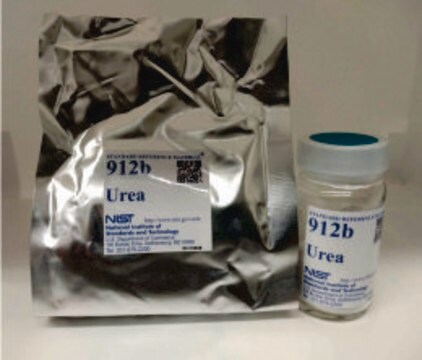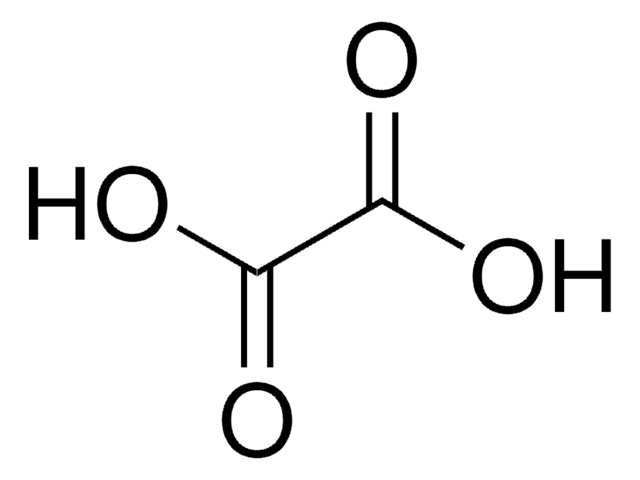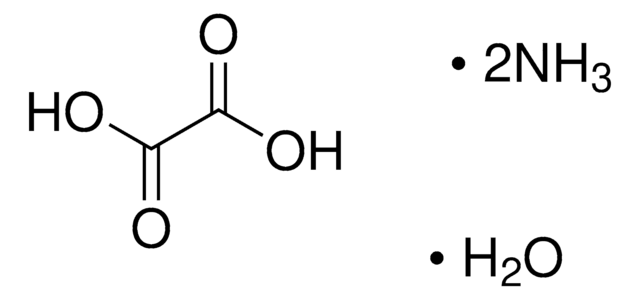Wszystkie zdjęcia(1)
Kluczowe dokumenty
About This Item
Wzór liniowy:
HOOCCOOH
Numer CAS:
Masa cząsteczkowa:
90.03
Numer MDL:
Kod UNSPSC:
12352106
Identyfikator substancji w PubChem:
Polecane produkty
klasa czystości
reagent
Formularz
liquid
dostępność
available only in Japan
stężenie
0.05 M
1/10 N
gęstość
1 g/cm3 at 20 °C
ciąg SMILES
OC(=O)C(O)=O
InChI
1S/C2H2O4/c3-1(4)2(5)6/h(H,3,4)(H,5,6)
Klucz InChI
MUBZPKHOEPUJKR-UHFFFAOYSA-N
Szukasz podobnych produktów? Odwiedź Przewodnik dotyczący porównywania produktów
Kod klasy składowania
12 - Non Combustible Liquids
Klasa zagrożenia wodnego (WGK)
nwg
Temperatura zapłonu (°F)
Not applicable
Temperatura zapłonu (°C)
Not applicable
Wybierz jedną z najnowszych wersji:
Masz już ten produkt?
Dokumenty związane z niedawno zakupionymi produktami zostały zamieszczone w Bibliotece dokumentów.
Xianlai Zeng et al.
Journal of hazardous materials, 295, 112-118 (2015-04-22)
With the booming of consumer electronics (CE) and electric vehicle (EV), a large number of spent lithium-ion battery (LIBs) have been generated worldwide. Resource depletion and environmental concern driven from the sustainable industry of CE and EV have motivated spent
Y Nakagawa et al.
The Journal of clinical investigation, 76(4), 1455-1462 (1985-10-01)
One reason that some people are prone to calcium oxalate nephrolithiasis is that they produce urine that is subnormal in its ability to inhibit the growth of calcium oxalate crystals. We have identified in human urine a glycoprotein (GCI) that
R de Water et al.
American journal of kidney diseases : the official journal of the National Kidney Foundation, 33(4), 761-771 (1999-04-09)
Urinary calcium oxalate (CaOx) crystals and crystal agglomerates are normally harmlessly excreted, but in nephrolithiasis they are retained by tubular epithelial cells and shifted into the renal interstitium. This crystalline material induces an inflammatory response consisting of an increase in
G M Gadd
Advances in microbial physiology, 41, 47-92 (1999-09-29)
The production of organic acids by fungi has profound implications for metal speciation, physiology and biogeochemical cycles. Biosynthesis of oxalic acid from glucose occurs by hydrolysis of oxaloacetate to oxalate and acetate catalysed by cytosolic oxaloacetase, whereas on citric acid
L K Massey et al.
Journal of agricultural and food chemistry, 49(9), 4262-4266 (2001-09-18)
Consumption of soybeans and food products made from them is increasing because of their desirable nutritional value. However, the oxalate content of seeds from 11 cultivars of soybean showed relatively high levels of total oxalate from 0.67 to 3.5 g/100
Nasz zespół naukowców ma doświadczenie we wszystkich obszarach badań, w tym w naukach przyrodniczych, materiałoznawstwie, syntezie chemicznej, chromatografii, analityce i wielu innych dziedzinach.
Skontaktuj się z zespołem ds. pomocy technicznej





